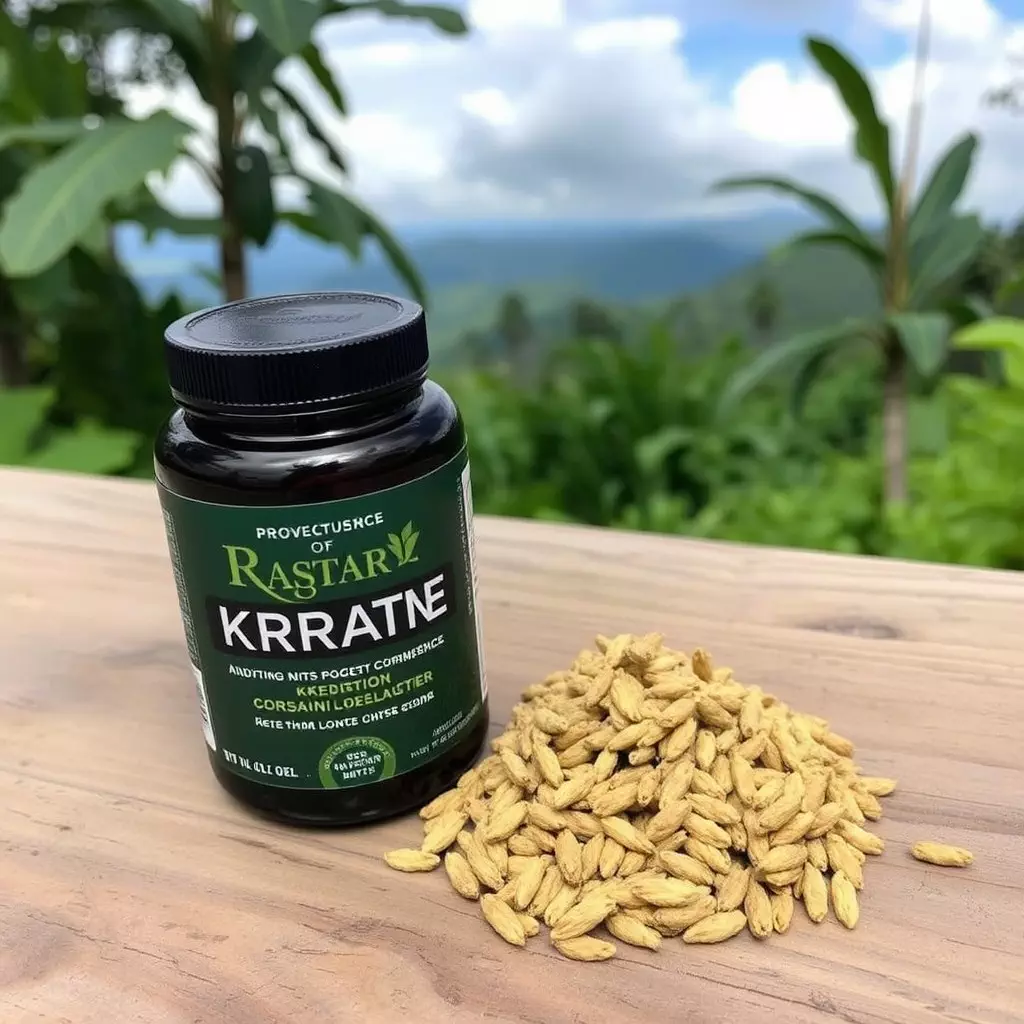Kratom, a plant from Southeast Asia containing compounds like mitragynine and 7-hydroxymitragynine, is recognized for its potential to prevent and manage injuries through its pain-relieving effects similar to opioids, but with fewer side effects. Its mood-enhancing and anti-anxiety properties can also aid mental resilience during recovery. By combining kratom with 'Thieves' oil in a diffuser, the healing process is potentially enhanced due to the synergy between the plant's active ingredients and the essential oils' immune support and anti-inflammatory benefits. 'Thieves' oil, which includes clove, lemon, cinnamon bark, rosemary, and eucalyptus, complements kratom to reduce inflammation and promote natural healing, making it a holistic approach for managing post-injury muscle soreness and pain. The article highlights the importance of choosing the right kratom strain, such as Maeng Da for its pain-relieving and energy-boosting properties, Bali for relaxation, Thai or Borneo for a balanced experience, and Indo from the Sumatra category for its combination of relaxation and stimulation. Aromatherapy with essential oils like eucalyptus or peppermint in a diffuser is also recommended to enhance healing by promoting relaxation and reducing inflammation. It's crucial to consult healthcare professionals before using kratom and to use aromatherapy safely and effectively as part of an injury recovery strategy, ensuring proper dosage and strain selection for the best outcomes. The therapeutic use of kratom and 'Thieves' oil together is suggested as a comprehensive method to support physical healing and create a calming atmosphere for rest and rejuvenation. Keywords: Kratom, diffuser Thieves integration, injury recovery, aromatherapy, essential oils.
Exploring the intersection of natural supplementation and injury prevention, this article delves into the potential benefits of kratom for managing muscle soreness and pain relief. With a focus on safe strain selection and its integration with complementary therapies such as aromatherapy diffusers—particularly those utilizing the Thieves blend—we uncover how kratom can play a pivotal role in recovery protocols, ensuring athletes and individuals maintain peak physical condition. Join us as we examine the science behind kratom’s properties and its synergistic effects when combined with essential oils for optimal injury management and prevention.
- Understanding Kratom's Role in Injury Prevention and Management for Muscle Soreness and Pain Relief
- Safe Kratom Strain Selection for Optimal Injury Prevention and Recovery
- Integrating Kratom with Complementary Therapies: The Role of Aromatherapy Diffusers and Essential Oils in Enhancing Recovery
Understanding Kratom's Role in Injury Prevention and Management for Muscle Soreness and Pain Relief

Kratom, a mitragynine-containing plant from Southeast Asia, has garnered attention for its potential role in injury prevention and management, particularly concerning muscle soreness and pain relief. Its active components, such as 7-hydroxymitragynine, interact with the body’s opioid receptors, providing analgesic effects that can help alleviate acute and chronic pain without the severe side effects associated with traditional pain medications. This makes kratom a valuable consideration for individuals looking to manage discomfort resulting from injuries or intense physical activity. Moreover, its ability to enhance mood and reduce anxiety may contribute to improved mental fortitude during recovery, which is crucial for adhering to rehabilitation protocols and preventing further injury.
Incorporating kratom into a holistic injury management plan can also include the use of essential oils like those found in the ‘Thieves’ blend by Young Living, often used in a diffuser. The combination of kratom’s pain-relieving properties and the therapeutic benefits of aromatic oils can create a synergistic effect that supports overall well-being. The ‘Thieves’ oil, with its blend of clove, lemon, cinnamon bark, rosemary, and eucalyptus essential oils, is known for its immune-boosting and anti-inflammatory properties, which can further aid in the recovery process by reducing inflammation and supporting the body’s natural healing mechanisms. This dual approach of kratom and essential oils can offer a comprehensive solution for those experiencing muscle soreness and pain associated with injury, enhancing the efficacy of injury prevention and management strategies.
Safe Kratom Strain Selection for Optimal Injury Prevention and Recovery

When considering kratom for injury prevention and management, it’s crucial to select strains that promote well-being without compromising safety. The Maeng Da strain, often favored for its invigorating effects, is a popular choice for those seeking pain relief and enhanced energy levels, which can be beneficial in the context of recovery from injuries. It’s also pivotal to consider how kratom interacts with your body, as different strains have varying alkaloid profiles that can influence their efficacy and safety. For instance, Bali Kratom is renowned for its soothing properties, which may aid in relaxation and stress relief, potentially complementing injury recovery and pain management regimens.
Safety should be the priority when integrating kratom into an injury prevention or management plan. The Thai strain, similar to the popular ‘Borneo’ variety, is known for its balanced alkaloid content, offering a gentler experience that may be more suitable for those sensitive to kratom’s effects. Additionally, the Indo strain, which falls under the ‘Sumatra’ category, is another option that provides a blend of relaxation and mild stimulation, making it a potential candidate for supporting recovery without overpowering the body. Always consult with healthcare professionals before introducing kratom into your wellness routine, as individual responses to kratom can vary significantly. Proper dosage and strain selection are key factors in ensuring that kratom supports injury prevention and recovery in a safe and effective manner. Using a diffuser for aromatherapy with essential oils like eucalyptus or peppermint can further enhance the healing process by promoting relaxation and reducing inflammation, complementing the pain-relieving effects of kratom.
Integrating Kratom with Complementary Therapies: The Role of Aromatherapy Diffusers and Essential Oils in Enhancing Recovery

Kratom, a plant from Southeast Asia with alkaloids that can affect the body’s pain and mood responses, has gained attention for its potential in injury prevention and management. When integrating kratom into recovery protocols, it’s beneficial to complement its effects with alternative therapies such as aromatherapy. Aromatherapy diffusers infused with essential oils can play a pivotal role in enhancing the healing process. The use of aromatherapy is rooted in ancient practices and modern research supports its efficacy in reducing stress, alleviating pain, and improving overall well-being.
A popular blend in aromatherapy for immune support and protection against pathogens is the ‘Thieves’ oil mix. This particular blend is often used in diffusers to create an environment that promotes healing and recovery. The Thieves essential oil blend, which typically includes clove, lemon, cinnamon bark, eucalyptus radiate, and rosemary, can be particularly effective for individuals recovering from injuries. Its antimicrobial properties help maintain a germ-free environment, which is crucial when the body’s defenses are compromised due to injury. By integrating a kratom regimen with the regular use of a Thieves diffuser, individuals can potentially achieve a more holistic approach to recovery, leveraging the analgesic and immune-boosting effects of both treatments. This synergy not only supports the physical healing but also contributes to a calming and conducive atmosphere for rest and rejuvenation.
In conclusion, the potential benefits of kratom in the context of injury prevention and management for muscle soreness and pain relief present an intriguing avenue for those seeking alternative approaches. Selecting the appropriate kratom strain is pivotal for maximizing its therapeutic effects without compromising safety. Moreover, the integration of kratom with complementary therapies such as aromatherapy, particularly through diffusers infused with ‘Thieves’ essential oil blend, may further enhance recovery by promoting a healing environment and improving overall well-being. As with any therapeutic practice, it is imperative to approach the use of kratom with caution and within the guidelines set forth by healthcare professionals. With careful consideration and responsible application, kratom could be a valuable addition to an individual’s injury prevention and management regimen.






